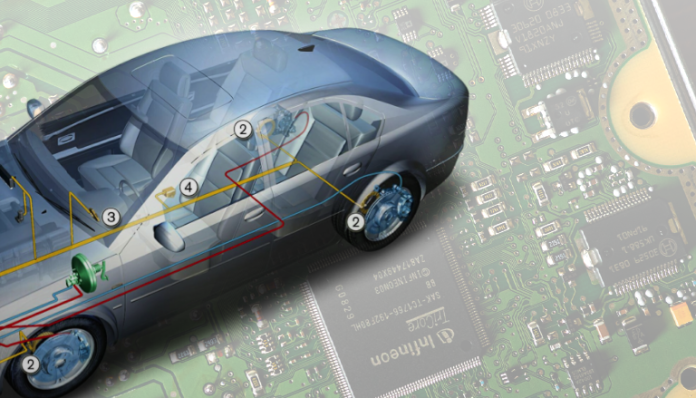The interface between a vehicle’s sensors and actuators is the ADAS ECU. The ADAS ECU is regarded as the vehicle’s “brain,” fusing information from cameras, radars, and other sensors at various levels to create a map of the immediate area, assess the situation, and take appropriate action.
ADAS ECUs possess these features:
- One or two MCU solutions
- ASIL D, integrated with ASIL C
- Adaptive AUTOSAR
- Security architecture
- Raw data-processing abilities
- Heterogeneous dynamic-scheduling support
- Support for SW diversity through tools and platforms
In order to provide a high-performance, future-proof platform for the development of innovative electronic control units (ECU) for driver assistance systems, the Austrian business TTTech Auto has planned to work with Renesas Electronics Corporation.
Renesas’ RH850/P1x automotive control microcontroller (MCU) and high-performance R-Car system-on-chips (SoCs) will be integrated with the TTIntegration solution, which is a software platform that enables highly complex automotive solutions, along with highly automated driving, as part of the automotive-platform solution. The development platform accomplishes parallel, multi-vendored development along with the integration of individual software components in addition to physical integration.
Purpose for collaboration
The partnership between TT Tech Auto and Renesas is intended to address current issues with software installation. Renesas brings its experience as a top-tier provider of semiconductor solutions to the automotive industry, offering high-performance and low-power semiconductor products to mass markets that need to implement safety and comfort features on a budget, including MCUs, SoCs, middleware, and development kits.
Through open application programming interfaces (APIs) and cutting-edge tools, Renesas offers system manufacturers the option and prompt integration of best-in-class software. For fulfilling the huge requirements for security in road traffic, Renesas provides 360-degree functional safety up to ASIL-D, which is the highest level of functional safety standard out of ASIL in its semiconductors. The developer has a high degree of scalability for goods that can span all segments, from premium to entry-level vehicles, thanks to the meticulous creation of product families.
TTIntegration and Deterministic Ethernet are the foundational components of TTTech’s ADAS technology.
As a bridge between the CPU level and the integrated apps, TTIntegration functions, while keeping hardware and program apart or even abstracting, gives each application the CPU time and memory it requires. As a result, the source of data and its use are firmly separated (location transparency). System manufacturers can migrate applications between embedded cores more simply by providing an AUTOSAR environment for a variety of operating systems. TTIntegration supports many levels of safety concurrently.
A rigid partitioning idea guarantees that at any time, a bug or fault in one particular application cannot impact any other applications or even bring down the entire ECU. According to the strictest automobile development safety standards, the concept guarantees “Freedom from Interference.” Deterministic Ethernet, a dependable and capable Ethernet backbone solution, is used by the platform solution for communication.
R-Car V4H and the Next-Generation AD/ADAS Solution
This solution creates a full development environment for Level 2-3 autonomous driving applications, such as adaptive cruise control (ACC), lane keeping, parking support systems, and more. The R-Car V4H reference board offers multiple camera inputs, including 4K display output, high-definition 4K, audio output, PCIe Gen4, and network communications interfaces, thereby allowing simultaneous use of numerous ECUs.
Additionally, Renesas offers a specific power solution built on the RAA271041 pre-regulator and the RAA271005 PMIC for R-Car V4H with functional safety support. Through a reduction in design complexity, expense, and time to market, this approach helps to minimize the work required for hardware and software development.
Benefits obtained from the systems
- Utilize the reference board that enables quick platform development to reduce the time to market.
- Offers a simple-to-use environment for system development using the R-Car compatible power management ICs, R-Car V4H starter kit, Flash memory, LPDDR5-6400 memory, output, and Ethernet 1000BASE-T in a small, discrete core system.
- Provides 34 TOPS from the R-Car V4H for deep learning, and for enabling the high-speed object detection using the fusion of sensor data from cameras, radars, and lidars.
- Offers 8 CAN channels, 2 CSI2 channels, 2 PCIe Gen4 channels, 4 RGMII, Ethernet channels, and 2 DSI channels.
CONCLUSION
The ADAS is supported by ECUs in contemporary automobiles help to further improve traffic safety. ADAS ECUs will take on more significant roles as the automotive ecosystem develops higher levels of automation and fully autonomous driving becomes the ultimate aim. The aforementioned assertions will examine the function and significance of the ADAS ECU by examining its architecture, historical development, and anticipated future function.

